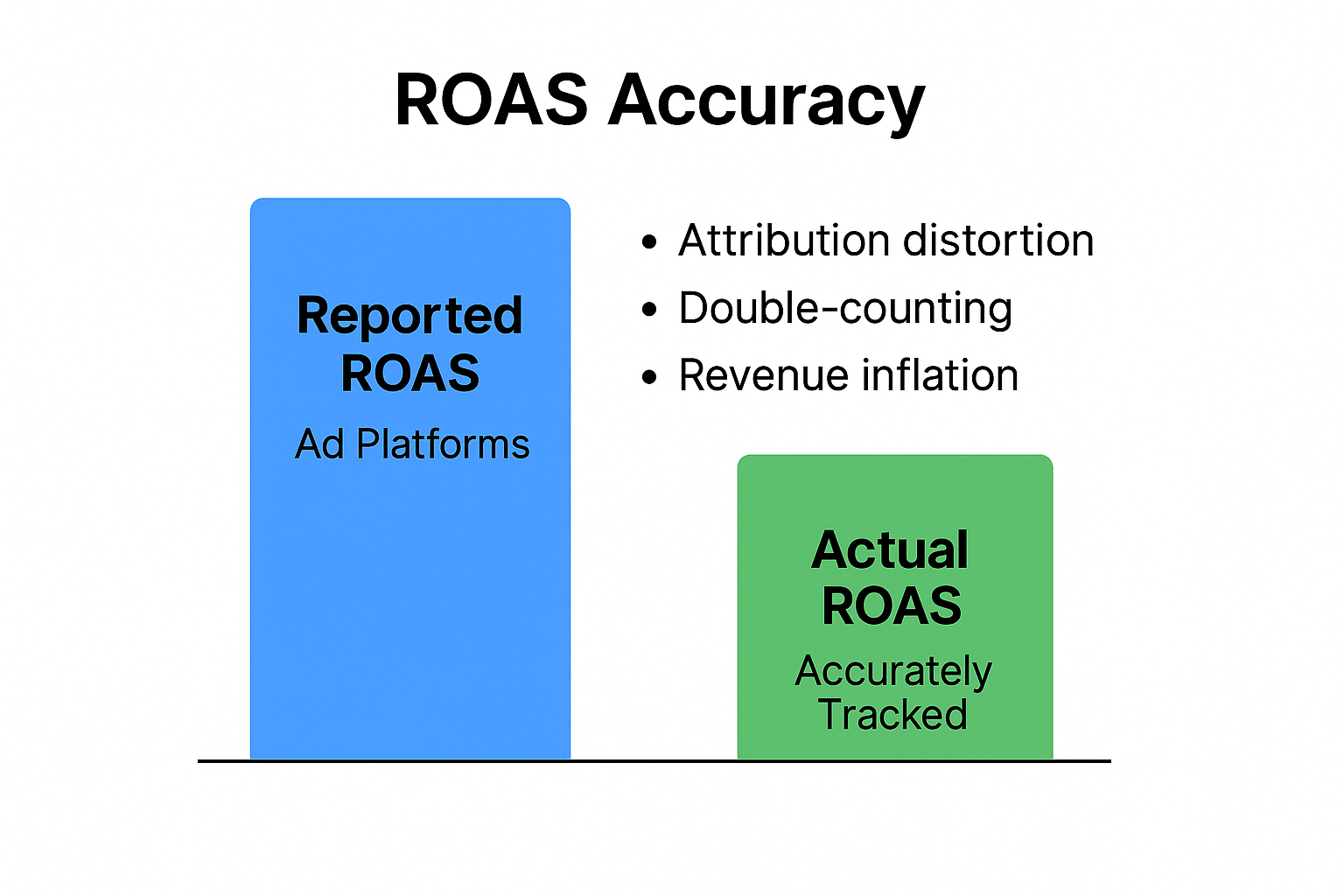Let’s start with a tough question.
Are you really tracking Return on Ad Spend (ROAS) across your campaigns accurately, or are you just trusting whatever Meta or Google spits out?
If you’re running ads across multiple platforms or campaign types, there’s a good chance your ROAS data is fragmented, inflated, or even flat-out misleading.
That’s dangerous. Because ROAS isn’t just a number — it’s your compass for profitable growth.
ROAS Isn’t One Thing. Here’s Why Most Marketers Miscalculate It.
The formula seems simple:
ROAS = Total Revenue / Total Ad Spend
But what counts as "revenue"? And what counts as "spend"?
Most mistakes in ROAS tracking come from mismatched definitions, incorrect attribution, or broken tracking setups.

Here are four common pitfalls:
-
Attribution mismatch — Facebook might count a sale that actually came from Google. Or vice versa.
-
Revenue inflation — Some marketers include tax or shipping fees in revenue. That’s a fast way to overestimate ROAS.
-
Multiple touchpoint confusion — Did that conversion come from an ad or from a retargeting email later?
-
Cross-platform double-counting — Meta and Google might both claim credit for the same purchase.
For a deeper look at how to interpret campaign metrics beyond ROAS, read How to Analyze Campaign Performance Beyond ROAS.
1. Unify Your Tracking — Without Overbuilding It
You don’t need a fancy data warehouse. You need consistency.
Here’s how to create a simple but effective system:
-
Use standardized UTM tracking across every campaign. Always label source, medium, campaign, content, and term clearly.
-
Pull revenue from your actual sales system, not just what Facebook reports. Shopify, WooCommerce, Stripe—whatever you're using, it should be your source of truth.
-
Use a central dashboard or sheet to combine spend + revenue from all platforms. Tools like Supermetrics, Triple Whale, or even Google Sheets with manual exports work.
-
Double-check event fires. If your Meta Pixel or conversion API is misfiring, your ROAS is fantasy.
Want faster learning and better optimization? Check out How to Finish the Facebook Learning Phase Quickly.
2. Group Campaigns by Intent, Not Platform
One of the biggest mistakes marketers make is analyzing ROAS by platform alone — Meta, Google, TikTok. That tells you almost nothing.
Instead, group your campaigns by buyer intent:
-
Cold audiences — New prospects, no previous brand interaction. Expect lower ROAS, focus on CPC/CTR.
-
Warm audiences — Engaged users, video viewers, site visitors. Here, mid-funnel ROAS matters most.
-
Hot audiences — Cart abandoners, email clickers, returning customers. ROAS should be 4x+ here.
Use a matrix like this weekly:
| Campaign Stage | Ad Spend | Revenue | ROAS |
|---|---|---|---|
| Cold | $4,000 | $2,800 | 0.7 |
| Warm | $2,000 | $4,500 | 2.25 |
| Hot | $1,000 | $6,000 | 6.0 |
This gives you a clearer view of which segments drive incremental profit and which just burn spend.
If your cold audience targeting is weak, revisit your setup with this guide: Facebook Ad Targeting 101.
3. Monitor ROAS Trends, Not Just Snapshots
Looking at yesterday’s ROAS is like driving with your rearview mirror.
You need trendlines.
Track ROAS over time:
-
7-day and 30-day rolling averages — Look for meaningful drops or spikes.
-
Day-of-week breakdowns — Does ROAS dip on weekends? Or spike midweek?
-
Creative-driven differences — Some creatives will spike ROAS fast, others decay quickly.
Also, be wary of what we call "the fatigue trap." Ads that used to work may quietly slip.
Read Ad Fatigue on Facebook: How to Spot It Early and Fix It Fast to avoid getting blindsided.
4. Improve ROAS With Smarter Creative Testing
Want to boost ROAS without touching targeting or budget? Test better creative.
Here’s a strategic framework:
-
Angle-first testing — Change the message, not just the color or button.
-
Hook and scroll testing — Focus on the first 3 seconds of your video or the first line of copy.
-
Use AI tools for drafts and concepts — See The Best AI Text and Image Generators in 2024 to test ideas faster.
Good creative often improves:
-
Engagement rate → cheaper clicks
-
Click-through rate → higher relevance scores
-
Conversion rate → better ROAS
All without increasing your ad budget.
5. Use LeadEnforce for High-ROAS Custom and Lookalike Audiences
ROAS is driven by relevance, and relevance starts with audience quality.
LeadEnforce helps you build custom audiences based on actual social group behavior, not just generic interests.

You can:
-
Create lookalikes of niche communities that already care about your topic.
-
Find high-intent audiences who engage with similar brands.
-
Reduce CPMs by avoiding oversaturated Meta interest categories.
That translates to better targeting, fewer wasted impressions, and higher ROAS.
You can explore how to build your target audience from a Facebook Group using LeadEnforce's data-layer capabilities.
6. Know When to Chase ROAS — And When to Look Beyond It
ROAS is a powerful metric. But it’s not the only one that matters.
High ROAS doesn’t always mean high profit. And low ROAS doesn’t always mean failure.
You should also look at:
-
Customer Acquisition Cost (CAC) — Is the cost to acquire sustainable?
-
Customer Lifetime Value (LTV) — Are you underinvesting in long-term buyers?
-
Blended ROAS or MER (Marketing Efficiency Ratio) — Are you profitable across all channels?
For context, read The ROAS Trap: Why High ROAS Isn’t Always Profitable.
Smart marketers don’t just track ROAS. They track the story behind it.
Final Takeaway: Clean Data = Profitable Scaling
If your data’s muddy, you’ll scale the wrong campaigns—or stop the right ones too early.
Track ROAS by:
-
Intent tier (not just platform);
-
Consistent attribution windows;
-
Actual purchase value.
And improve it by:
-
Testing sharper creative;
-
Targeting smarter audiences;
-
Watching trends over time, not just snapshots.
When you get your ROAS foundation right, scaling becomes simple.

